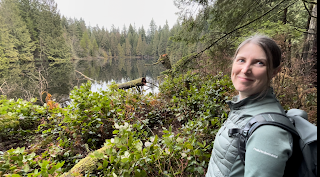Exploring Water Through Sound, Movement, and Mathematics
This is an outline of what Joy and I hope to accomplish in our final project. It is based on a larger project that we began last term with Cynthia: an outdoor math blog guided by the principles of Indigenous Storywork. You can check it out here if you like: Outdoor Math
Guided by the Indigenous Storywork R of Respect, we will be using movement and vocalizations to come to know water better. Mathematics will help us transform these vocalizations and movements into unique songs and dances.
Creating Water Songs Level 1 (Primary): Observing, collecting, representing, classifying, patterning
Listen to and engage with water in different contexts (Indoor: water tables, bathtubs and sinks, water fountains. Outdoor: different kinds of rain, puddles, creeks, gutters, oceans…)
Collectively create vocalizations that remind them of different sounds.
Create words and visuals to help them remember the sounds.
Sort and classify sounds (examples: deep, long, soft, fast, slow, light, heavy). Create graphical representation to show classification.
Create original sound patterns (water songs) by arranging word visuals. Whole class participates in singing sound patterns.
Creating Water Songs Level 2 (Intermediate): Observing, collecting, representing, measuring, comparing, patterning
Same initial start as primary (steps 1-4)
“Measuring” sounds by comparing to whole, half, quarter, eighth, sixteenth notes. Choosing sounds to match each sound measurement.
Representing various notes by folding/cutting coloured paper. Whole paper = whole note (etc). Each note is represented by a different colour.
Students work in partners to compose sound patterns by arranging fractional portions of paper. Glue down to create a bar of their song.
Partners grouped with other partners to create longer songs. Groups practice water songs by reading their music, using vocalizations and percussion to punctuate the beginning of each note.
Creating Water Dances (any level): Observing, representing, patterning
Observing and collecting water movements in different contexts
Representing water movements by analogous body movements
Representing body movements with graphics
Patterning and arranging graphics to create water dances. Can set to music.
Sharing and performing water dance patterns.
We will be using the following “lenses” to guide this project:
Holistic, Multifaceted Approaches to Learning (week 4)
Related to Ecojustice Mathematics, Indigenous Storywork, FPPL
The so-called “barrier” between arts/humanities and math/sciences is a modern, western, Eurocentric construct
Many cultures around the world and over time were enriched by bringing these disciplines together (medieval Europe, Persia, Anishnaabe)
Embodied, multisensory, outdoors and arts-based modalities (week 2 and 5)
Sight and hearing are not the only ways to sense math
Embodied metaphors may help students take their learning to greater depths (and heights!)
“A pedagogy that offers nothing but (a) kind of passive reception of teacher lectures results in an impoverished mathematical education for the majority of students, who do not thrive in such circumstances”
Use of Cognitive Tools (Egan) and Imaginative Education A brief guide to Imaginative Education
Ecojustice Mathematics:
Mathematics has an important role to play in helping everyone construct an understanding of the world.
Mathematics can and should empower everyone to think for themselves.
Mathematics enriches the mind, body, and spirit of people by helping them notice and make connections to the living world
Noticing through mathematics can lead to caring
Caring and connection can lead to the protection and healing of our world
Indigenous Storywork:
Education should honour heart, mind, and body connections.
The 4 R’s of Indigenous Storywork (Reverence, Respect, Responsibility, and Reciprocity) help us better understand our roles as listeners, observers, and teachers. They help us learn well from stories, whether those stories are shared by humans or more-than-humans.
Bibliography:
Please note that we began this reference list last term. We are deepening our understanding by adding to this reference list. The new references we are adding have been highlighted in yellow.
Adams, K. (2019). Stem education and the miracle of life. In A pedagogy of responsibility: Wendell Berry for Ecojustice Education (pp. 117–135). Routledge, Taylor & Francis Group.
Archibald, J., Fast, J., Fox, S., Nicol, C., Rodger, L., Whiffin, J., & Yovanovich, J. (2021, November 24). Indigenous Storywork and Math Education [Webinar]. In Re-Imagining Mathematics Education Webinar Series. https://elvlc.educ.ubc.ca/initiatives/connecting-math/
Archibald, Jo-ann. (2008). Indigenous Storywork: Educating the Heart, Mind, Body, and Spirit. UBC Press.
Bishop, A. J. 1988 Mathematical Enculturation: A cultural perspective on Mathematics Education, D. Reidel Publishing Company, 100-103.
https://www.csus.edu/indiv/o/oreyd/acp.htm_files/abishop.htm
Bishop, A. J. (1997). Mathematical Enculturation: A cultural perspective on mathematics education. Kluwer.
Brown, M. W. (2009). The teacher-tool relationship: theorizing the design and usc of curriculum materials. In J. T. Remillard, B. A. Herbel-Eisenmann, & G. M. Lloyd (Eds.), Mathematics teachers at work: Connections curriculum materials and classroom instruction (PI" 17-36). NewYork, NY: Routltedge.
D’Ignazio, C., & Klein, L. F. (2020). Data feminism. The MIT Press.
Kimmerer, R.W. (2015). Braiding Sweetgrass. Milkweed Editions.
Kuo, M., Barnes, M., & Jordan, C. (2019) Do experiences with nature promote learning? Converging evidence of a cause-and-effect relationship. Frontier in Psychology 10:305. doi: 10.3389/fpsyg.2019.00305
Latremouille, J. (2020). The ecological pedagogy of joy. The SAGE Handbook of Critical Pedagogies (pp. 2-25).
Macedonia, M. (2019). Embodied learning: Why at school the mind needs the body. Frontiers in Psychology, 10. https://doi.org/10.3389/fpsyg.2019.02098
Martusewicz, R. A. (2019). A pedagogy of responsibility: Wendell Berry for Ecojustice Education. Routledge, Taylor & Francis Group.
Nicol, C., Dawson, A.J., Archibald, J., & Glanfield, F. (Eds). (2020). Living culturally responsive mathematics with/in Indigenous communities. Brill/Sense Publishers.
Nathan, M. J. (2022). Foundations of embodied learning: A paradigm for education. Routledge.
Wagamese, R. (2019). Medicine walk. McClelland & Stewart.
Wiseman, D., Lunney Borden, L., Beatty, R., Jao, L., & Carter, E. (2020). Whole-some artifacts: (STEM) teaching and learning emerging from and contributing to community. Canadian Journal of Science, Mathematics and Technology Education, 20(2), 264-280.
Wolfmeyer, M., Lupinacci, J., & Chesky, N. (2017). EcoJustice mathematics education: An ecocritical (re)consideration for 21st century curricular challenges. Journal of Curriculum Theorizing, 32(2), 53-71.



Comments
Post a Comment